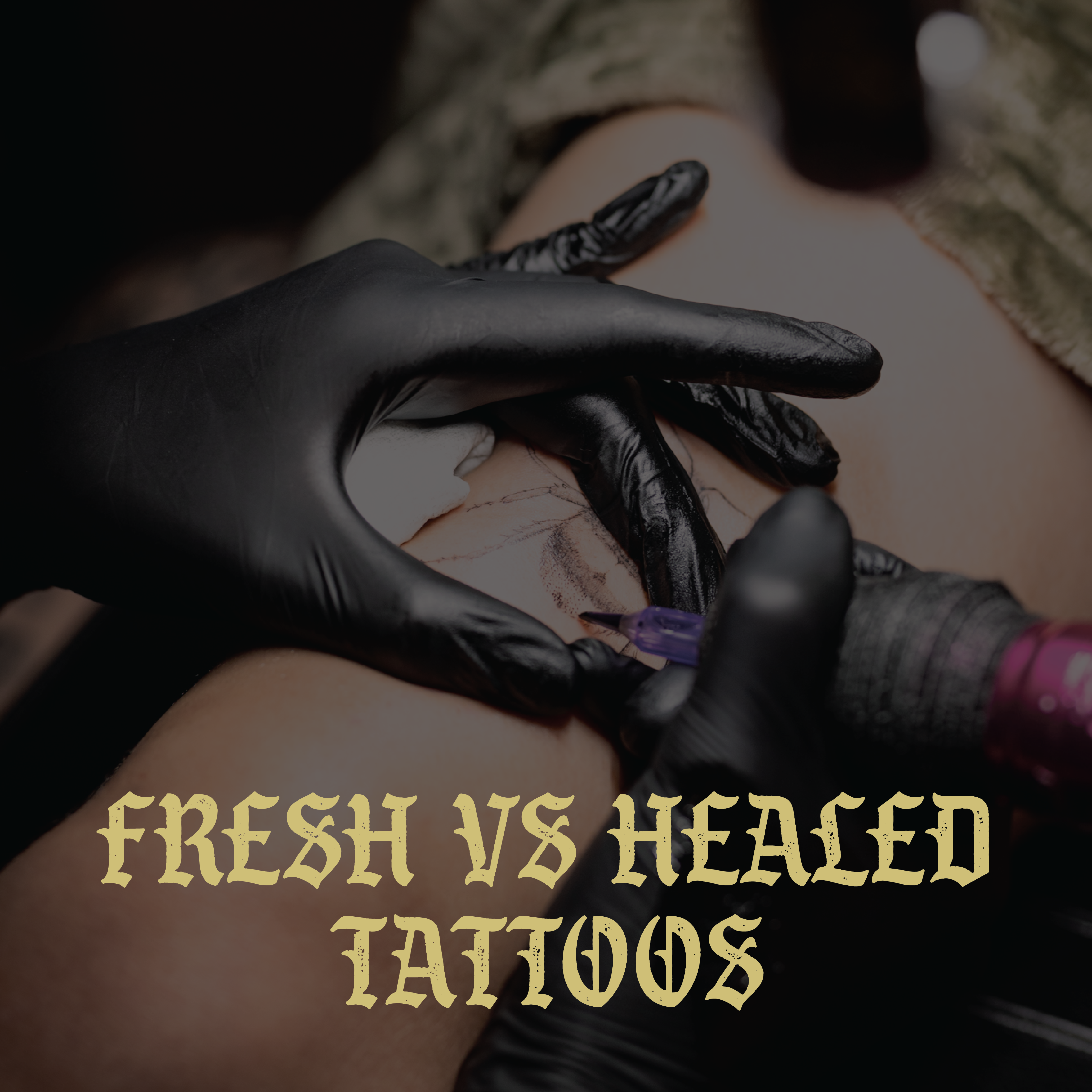
As soon as the artist puts the last line in, your new tattoo looks sharp, bright and flawless. However, a few weeks later, the colors, lines and shadows seem softer. Don’t panic: that’s completely normal. It’s all part of the natural tattoo healing process.
In this article, we’ll explain what happens while your tattoo heals, why some tattoos heal differently than expected and how proper tattoo aftercare helps your ink stay vibrant for years to come. We’ll also show real fresh vs healed tattoo photos from our BlackBear Ink artists.
A fresh tattoo is, in fact, an open wound. The skin has been punctured thousands of times with needles, so redness, swelling and a slight shine are totally normal. In this stage, the colors appear super bright and the lines extra crisp because there’s no new skin covering the ink yet.
Proper tattoo aftercare is crucial: keep your tattoo clean, apply a thin layer of healing ointment, and protect it from dirt, sun, and friction. Mistakes like scratching or soaking in water can slow the healing process and affect the final result. Read this article that dives deeper into the world of tattoo aftercare.
As your tattoo heals, a new transparent layer of skin forms over the ink. This layer changes how light reflects off your tattoo, making the colors appear softer. That doesn’t mean your tattoo has “faded”- it’s simply part of the tattoo healing process.
If aftercare isn’t followed correctly (too much sun exposure or scratching, for example), real fading or color loss can happen. That’s why the healing phase is just as important as getting the tattoo itself.
After about six weeks, your tattoo is fully healed. The skin feels normal again, and the colors look slightly softer and more natural. A healed tattoo should have even color, no scabs or flakes and feel smooth to the touch.
Regular hydration and lifelong (like, until the day you can’t lift your arms because you’re dead) UV protection will keep your tattoo looking sharp and vibrant for years to come.
Blowouts (when ink spreads under the skin, creating a blurry or uneven patch) happen more often with inexperienced artists, but even pros can encounter them. A blowout occurs when the needle goes too deep, pushing ink into the wrong skin layer.
Because every person’s skin, connective tissue and pigment are different (and every body part too), healing can vary. That’s also why some tattoos hurt more than others and why the same artist’s work can heal slightly differently depending on placement.
The opposite can happen as well: if the ink isn’t placed deep enough, your tattoo might fade faster and need a touch-up. Luckily, that’s much easier to fix than a blowout.
Fineline tattoos are more delicate by nature. Artists tend to work carefully and shallowly to achieve those precise, minimalist lines, which can affect how the tattoo heals.
Check out our full guide: “The Ultimate Tattoo Aftercare Routine” : a step-by-step breakdown covering everything from foil or Second Skin use to moisturizing schedules and the lifelong importance of sun protection.
Proper tattoo aftercare is the secret to ink that stays crisp and vibrant for years to come.

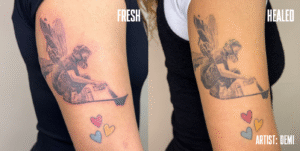
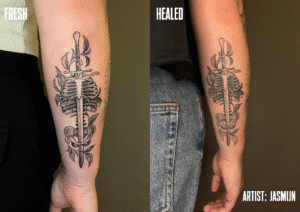

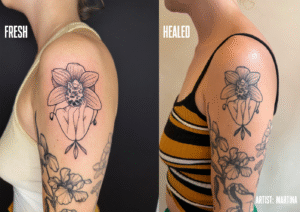


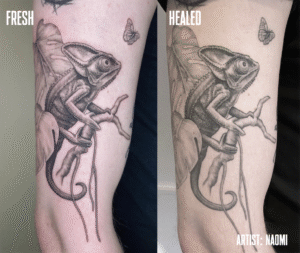
A new tattoo always looks stunning at first, but during tattoo healing, its appearance naturally changes. Colors soften, lines lose a bit of their sharpness and that’s all part of your skin’s recovery.
Follow your artist’s instructions carefully, protect your tattoo from sunlight and moisturize regularly. This helps prevent fading or other issues and keeps your ink bold, smooth, and beautiful.
If you’re unsure about your tattoo’s healing process or wondering about touch-ups or care, contact your artist to make sure your tattoo stays flawless for the long run.
A tattoo is an investment in your skin. Treat it with love from day one. 🖤
On average, it takes about six weeks for a tattoo to fully heal. The top layer of skin usually recovers within two weeks, but deeper layers take longer. During this time, proper tattoo aftercare is essential to maintain the best results.
Only if you want to end up in tattoo jail. So in short: NOPE. UV light is your new tattoo’s worst enemy. UV light can damage the ink and slow down healing. Avoid direct sunlight until your tattoo is fully healed and always use a high SPF sunscreen forever (yes, even after the grave).
Totally normal. Peeling and flaking are part of your skin’s natural renewal process, which may include shedding some excess pigment.
🗣️ Don’t scratch or pick at it! Let the skin shed naturally and keep moisturizing lightly with a tattoo healing balm.
A tattoo blowout happens when the ink is placed too deep and spreads under the skin. It usually doesn’t disappear on its own, but it can be corrected with a touch-up or cover-up. When in doubt, have your tattoo checked by an experienced artist.
Wait until your tattoo is completely healed (usually around six weeks). Touching up earlier can damage the healing skin and affect the final look. A good artist will tell you if and when a touch-up is needed.
Good tattoo aftercare = beautiful tattoos for life.
Treat your skin well, and your ink will thank you forever. 🖤
